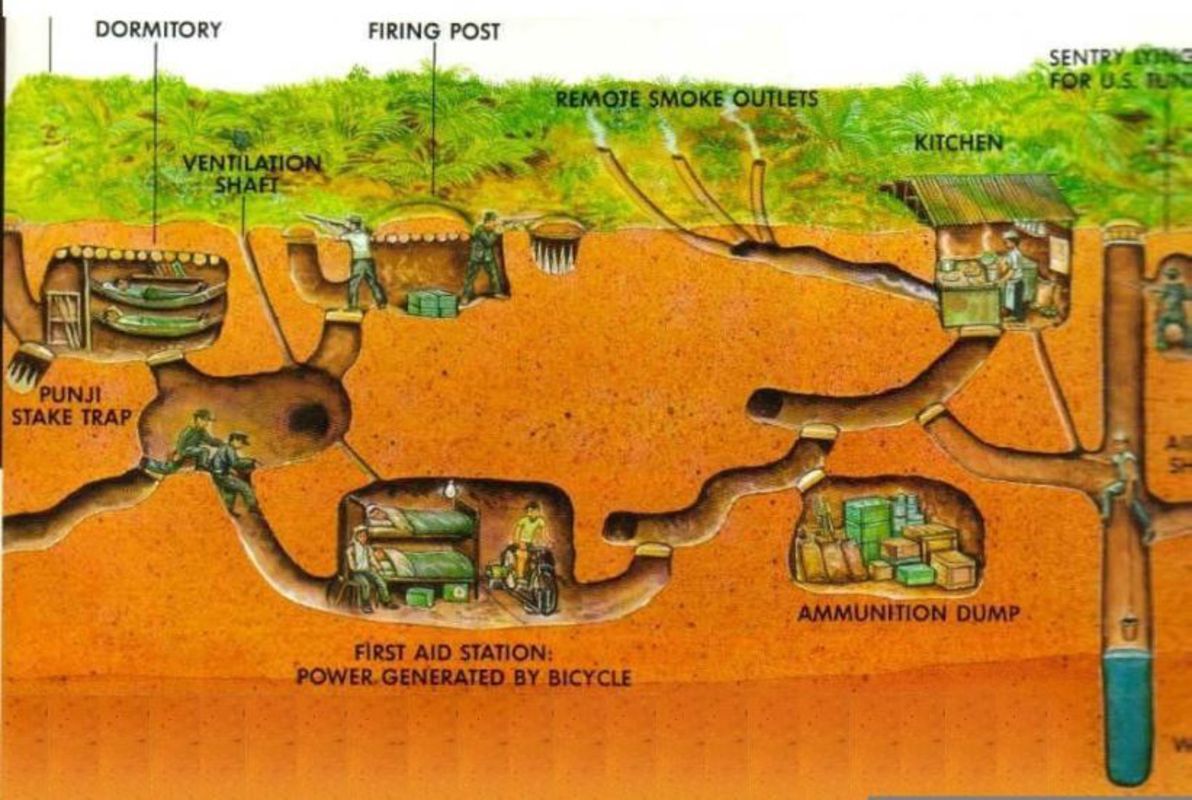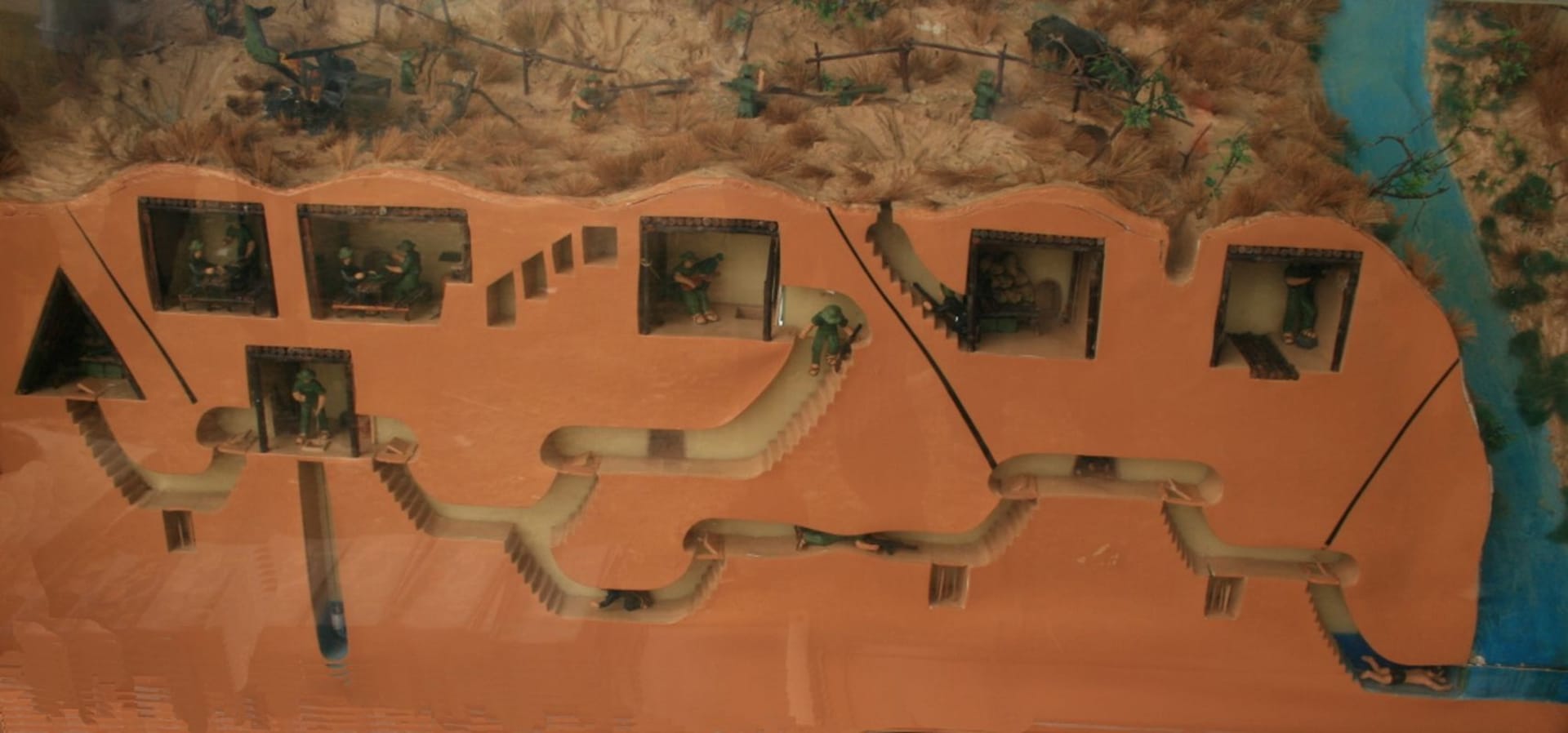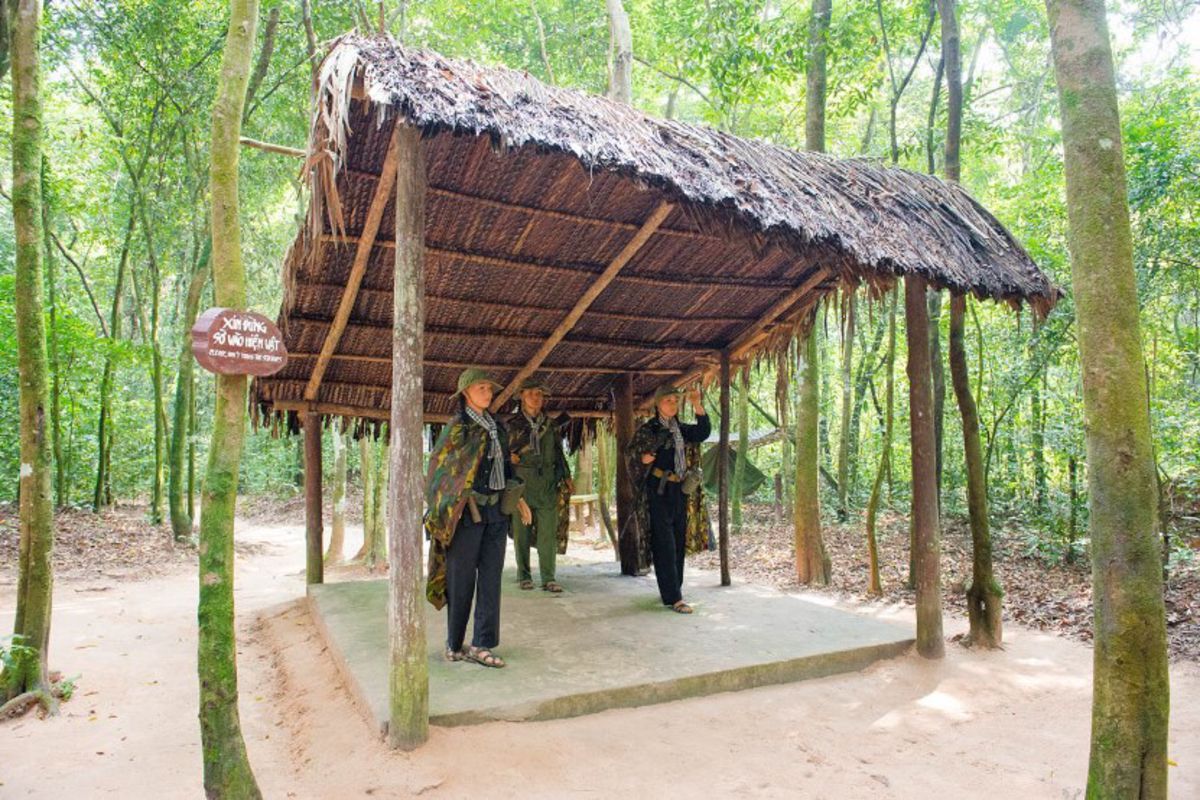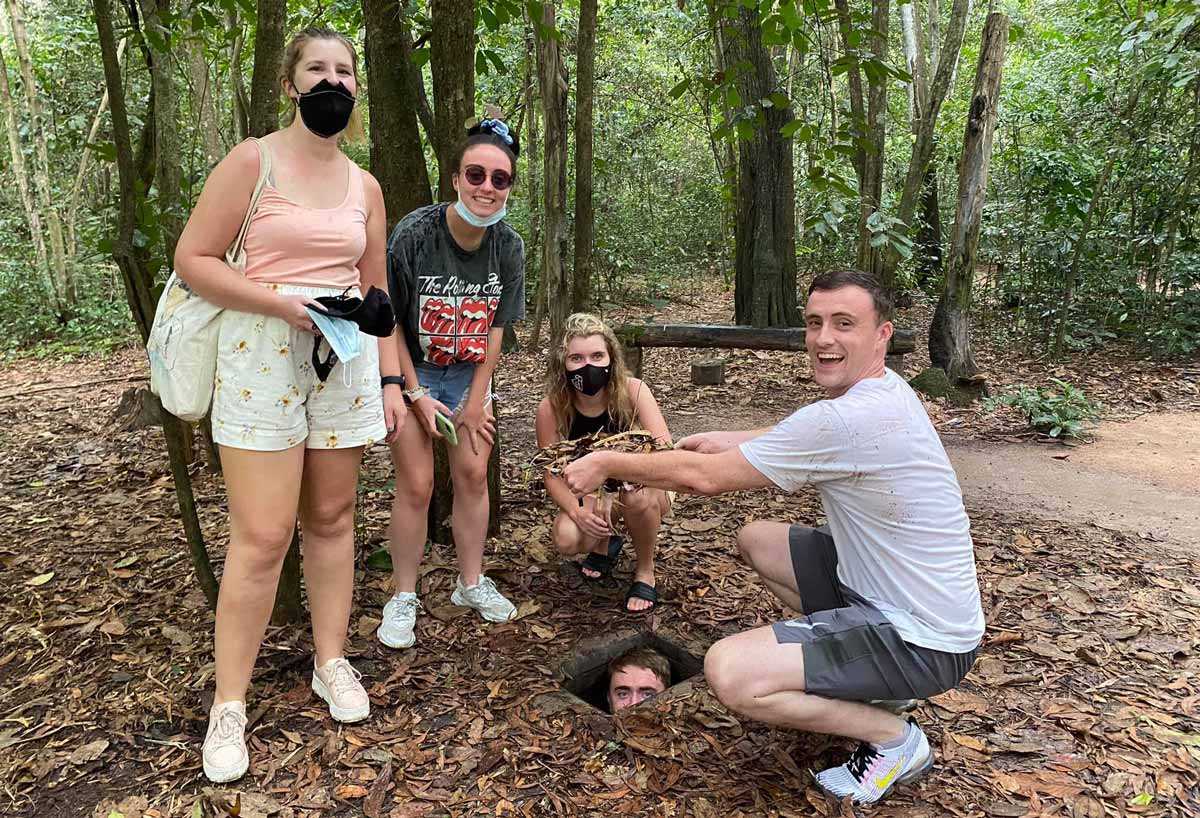Explore the Cu Chi Tunnels’ ingenious architecture near Ho Chi Minh City! Join Legend Travel Group’s eco-tours in Saigon to uncover Vietnam’s history. Book now!
A Masterpiece of Wartime Ingenuity
Nestled in Cu Chi Ward, ~70 km northwest of Ho Chi Minh City’s Ward 1, the Cu Chi Tunnels are an architectural marvel, drawing over 1.5 million visitors annually to their 250-km underground network. Built from 1946 to 1968 during the First Indochina War (1945–1954) and Vietnam War (1955–1975), these tunnels feature a multi-level design with hidden entrances, ventilation systems, and living quarters, showcasing Viet Cong resilience. A national monument, their intricate structure captivates architects and historians in a 6,772 km² megacity. Legend Travel Group’s eco-friendly tours, using low-emission vehicles, offer a sustainable way to explore this subterranean wonder, supporting local communities. Discover Vietnam’s architectural legacy—book our tours via links throughout this guide or contact us at WhatsApp: +84825862222 or sales@legendtravelgroup.com! TripAdvisor Ho Chi Minh City
Administrative Update
Vietnam recently merged Binh Duong and Ba Ria-Vung Tau into Ho Chi Minh City, forming a 6,772 km² megacity with 13.7 million residents across 168 wards, including Cu Chi District now Cu Chi Ward. This reorganization enhances tunnel access with upgraded roads, bus routes, and a VND1 trillion flood control project, connecting Cu Chi Ward to urban Ward 1 and suburban Can Gio.
Legend Travel Group, a leading Southeast Asia tour operator, offers curated, eco-conscious tours to the Cu Chi Tunnels. Our tours use low-emission vehicles and bicycles, guided by experts sharing the tunnels’ architectural secrets. Supporting communities in Cu Chi Ward, Ward 1, and Thu Duc, we align with the city’s “Green Metropolis” vision. With transparent pricing, free cancellations up to 48 hours before departure, and 24/7 support, we ensure a seamless experience. Book our eco-tours via links on this page and explore sustainably! TripAdvisor Reviews
 Photograph the innovative allure of Ho Chi Minh City’s heritage (Source: Internet)
Photograph the innovative allure of Ho Chi Minh City’s heritage (Source: Internet)Located in Cu Chi Ward, ~70 km from Ho Chi Minh City’s Ward 1, the Cu Chi Tunnels are a 250-km underground network, hand-dug from 1946 to 1968 across Cu Chi and Hoc Mon wards. Set in a tropical monsoon climate—dry season (December–April, 25–35°C or 77–95°F) and rainy season (May–November, 23–32°C or 73.4–89.6°F)—the tunnels feature Ben Dinh and Ben Duoc sites, open daily from 7:00 AM to 5:00 PM. Designed for Viet Cong guerrilla operations, the three-level system, at depths of 3–12 m, includes narrow passages, hidden entrances, and facilities like Hoang Cam kitchens and hospitals. Restored as a national monument, the tunnels offer crawlable sections and exhibits, accessible via bus or guided tours, near the Saigon River.
The Cu Chi Tunnels were hand-dug over two decades (1946–1968) by Viet Minh and Viet Cong fighters using bamboo tools and manual labor, often under cover of night to evade detection. Construction involved:
Teams and Techniques: Groups of 5–10 villagers, including men and women, dug tunnels and dispersed soil in rivers or fields to conceal activity. Women often camouflaged soil piles or planted vegetation over entrances.
Camouflage Strategies: Entrances, as small as 30x40 cm, were hidden under termite mounds, roots, or leaves. Ventilation shafts used bamboo pipes disguised as stumps, with pepper sprinkled to deter U.S. sniffer dogs.
Resourcefulness: Soil was stabilized with compacted earth, not reinforced materials, to maintain flexibility. Tunnels followed natural terrain, curving to disrupt enemy probing or gas attacks.
Community Effort: Entire villages contributed, with children acting as lookouts and elders providing food, sustaining construction despite bombings.
This labor-intensive process created a resilient network, recognized as a national monument in 1979 (Ben Duoc) and 2004 (Ben Dinh), showcasing Vietnam’s architectural ingenuity.
 Learn Ho Chi Minh City’s wartime legacy with expert insights (Source: Internet)
Learn Ho Chi Minh City’s wartime legacy with expert insights (Source: Internet)Well, 15m deep, clear. The tunnel system consists of 3 floors, from the "backbone" line radiates long branches, short branches link through each other, branching out to the Saigon River. The floor is 3m above the ground, resistant to artillery shells and weight of tanks, armoured vehicles. Level 2 is 5 meters away from the ground, can resist small bombs. The last floor is 8-10m from the ground very safe. The way up and down between the basements is arranged with secret tunnels. The tunnel with broad tunnels for rest, a place to store weapons, food, wells, Hoang Cam stove, commanding tunnel ... There are also large tunnels, roofs cool, camouflage ingenious to watch movies, arts.
The Cu Chi Tunnels’ architecture remains a testament to wartime engineering, with restored sections at Ben Dinh and Ben Duoc revealing its sophisticated design:
Three-Level Structure:
Level 1 (3–4 m deep): Resistant to artillery, used for quick access and combat, with multiple trapdoors.
Level 2 (5–6 m deep): Housing meeting rooms, kitchens, and hospitals, fortified against small bombs.
Level 3 (8–12 m deep): Safest level for command centers and storage, with connections to the Saigon River for escape.
Narrow Passages: Tunnels are 0.5–1 m wide and 0.8–1.2 m high, designed for agility and defense, with zigzags to block blasts.
Ventilation Systems: Bamboo pipes, hidden as stumps, provided air, angled to prevent flooding.
Hoang Cam Kitchens: Smokeless stoves dispersed smoke through multi-tiered vents, concealing cooking activity.
Facilities: Included wells, storage rooms, medical bays, and theaters, with cool, camouflaged roofs for cultural events.
Camouflage: Entrances under termite mounds or roots remain nearly invisible, preserving the tunnels’ secrecy.
Restored for tourism, the tunnels offer crawlable sections (20–100 m) and exhibits, drawing 1.5 million visitors annually to Cu Chi Ward.
 Seize the resilient spirit of Ho Chi Minh City Travel (Source: Internet)
Seize the resilient spirit of Ho Chi Minh City Travel (Source: Internet)Crawl Tunnels: Navigate restored 20–100-meter sections at Ben Dinh or Ben Duoc to feel the narrow, multi-level design ($5 or 116,000 VND entry).
View Exhibits: Explore displays of ventilation shafts, Hoang Cam kitchens, and trapdoors to understand construction techniques (included in entry).
Visit Ben Duoc Temple: Admire the memorial’s architecture, blending modern and traditional elements, honoring tunnel builders (included in entry).
Watch Documentaries: Learn about tunnel design in visitor center films (included in entry).
Join Guided Tours: Our eco-friendly tours ($50–$70) provide expert insights into the tunnels’ architecture, with safe transport.
Tip: Book our Saigon Historical Tour ($50–$70) for a guided architectural exploration.
The Cu Chi Tunnels in Cu Chi Ward are accessible from Ho Chi Minh City’s transport hub:
By Air: Tan Son Nhat International Airport (SGN), in Tan Binh Ward, serves 40 million passengers annually via Terminal T3 (Vietnam Airlines domestic) and T1/T2. Round-trip costs:
Hanoi: $80–$150 (2,000,000–3,750,000 VND).
Da Nang: $60–$120 (1,500,000–3,000,000 VND).
Bangkok/Singapore: $200–$500.
Taxis/Grab to Ward 1 (7 km): $5–$8 (120,000–200,000 VND).
By Bus: From Hanoi (30–34 hours, $35–$60 or 875,000–1,500,000 VND), Da Nang (18–22 hours, $20–$40 or 500,000–1,000,000 VND), or Can Tho (3–4 hours, $5–$10 or 125,000–250,000 VND). Local bus #79 from Ward 1 to Cu Chi: $1.30 (30,000 VND, 2 hours).
By Train: Saigon Railway Station in Ward 7 connects to Hanoi (30–34 hours, $40–$80 or 1,000,000–2,000,000 VND). A high-speed rail is planned for 2030.
Getting to Cu Chi Tunnels:
Bus #79: From Ben Thanh Market (Ward 1) to Cu Chi Bus Station, $1.30 (30,000 VND), then Grab ($3 or 75,000 VND, 15 minutes).
Grab/Taxi: $30–$40 (750,000–1,000,000 VND) one-way from Ward 1, 1.5 hours.
Guided Tours: $50–$70 (half-day), including eco-friendly transport and guide.
Motorbike Rental: $5–$10/day (125,000–250,000 VND), 1.5 hours, but requires skilled drivers.
Tip: Book our Saigon Historical Tour ($50–$70) for eco-friendly transport.
 Embrace the vibrant spirit of Ho Chi Minh City Travel adventures (Source: Internet)
Embrace the vibrant spirit of Ho Chi Minh City Travel adventures (Source: Internet)The dry season (December–April) offers sunny weather (25–35°C or 77–95°F), ideal for exploring tunnel entrances and outdoor exhibits. Tet (January–February) brings festive decorations but larger crowds. The rainy season (May–November) features cooler temperatures (23–32°C or 73.4–89.6°F) and 15–25% tour discounts, with covered exhibits suitable during showers. Morning visits (7:00 AM–10:00 AM) avoid crowds and heat, while April 30th (Reunification Day) offers special displays but higher foot traffic.
Tip: Book tours 3–5 weeks ahead for December–April; visit early for clearer views. Check AccuWeather for rainy season updates.
Pack these essentials for a comfortable visit:
Clothing: Lightweight, breathable outfits for dry season; waterproof jackets for rainy season. Long sleeves and pants for tunnel crawling.
Sun Protection: SPF 50+ sunscreen, sunglasses, wide-brimmed hat for outdoor areas.
Footwear: Sturdy, closed-toe shoes for uneven terrain; avoid sandals.
Travel Essentials: Reusable water bottle, compact umbrella, mosquito repellent.
Tech Gear: Smartphone with Maps.me, portable charger, camera for photos (non-flash in exhibits).
Documents: Passport copy, travel insurance, tour confirmations, VND (50,000–200,000 notes).
Eco-Friendly Items: Reusable tote bag, sketchbook for noting architectural details.
Tip: Carry small VND notes for snacks; bring a flashlight for tunnel exploration.
Navigate 20–100-meter restored tunnels at Ben Dinh or Ben Duoc, showcasing the narrow, zigzagged design.
Cost: Included in entry: $5 (116,000 VND) adults.
Hours: Daily, 7:00 AM–5:00 PM.
Tip: Included in our Saigon Historical Tour ($50–$70).
Observe bamboo-pipe vents disguised as stumps, a key architectural feature.
Cost: Included in entry ticket.
Hours: Daily, 7:00 AM–5:00 PM.
Tip: Guided in our Saigon Historical Tour ($50–$70).
View smokeless stoves with multi-tiered vents, a clever design for concealment.
Cost: Included in entry ticket.
Hours: Daily, 7:00 AM–5:00 PM.
Tip: Included in our Saigon Adventure Tour ($60–$80).
Return to Ward 1 (~70 km) to explore this 1914 French colonial market’s architecture.
Cost: Free; souvenirs $1–$20 (25,000–500,000 VND).
Hours: Daily, 6:00 AM–5:00 PM.
Tip: Included in our Saigon Cultural Tour ($50–$70).
Discover this 1966 modernist palace in Ward 1, ~70 km from the tunnels.
Cost: Adults $3.45 (80,000 VND); children $0.85 (20,000 VND).
Hours: Daily, 8:00 AM–4:30 PM.
Tip: Included in our Saigon Heritage Tour ($50–$70).
Tunnel Costs
Entry: $5 (116,000 VND) adults; $2.50 (58,000 VND) children (6–15); free for under 6.
Audio Guide: $2 (50,000 VND).
Firing Range: $2–$5 per round (50,000–125,000 VND, minimum 10 rounds).
Transportation
Bus #79: $1.30 (30,000 VND) from Ward 1 to Cu Chi, plus Grab ($3 or 75,000 VND).
Grab/Taxi: $30–$40 (750,000–1,000,000 VND) one-way from Ward 1.
Guided Tours: $50–$70 (half-day), $100–$150 (full-day with Mekong Delta).
Motorbike Rental: $5–$10/day (125,000–250,000 VND).
Dining (On-site or Nearby)
Cafes: $5–$15 (125,000–375,000 VND) for meals.
Drinks: $0.50–$3 (12,500–75,000 VND).
Accommodation (Ward 1 or Cu Chi Ward)
Hostels: $8–$20/night (200,000–500,000 VND).
Hotels: $25–$80/night (625,000–2,000,000 VND).
Resorts: $100–$250/night (2,500,000–6,250,000 VND).
Total Daily Cost
Budget: $20–$50 (includes entry, bus, meals).
Mid-range: $50–$100 (includes tour, Grab, dining).
Luxury: $150–$300 (includes private tour, upscale lodging).
Tip: Carry VND for small purchases; ATMs are limited in Cu Chi Ward.
Book Early: Reserve tours via Legend Travel Group (WhatsApp: +84825862222, sales@legendtravelgroup.com) 3–5 weeks ahead, especially for December–April or April 30th.
Seasonal Tips:
Dry Season: Use sunscreen; visit early for clear outdoor views.
Rainy Season: Carry raincoats ($2–$5 or 50,000–125,000 VND); focus on indoor exhibits.
Health Precautions: Avoid tunnels if claustrophobic or have respiratory issues; stay hydrated.
Sustainability: Choose eco-friendly tours; support local cafes near the site.
Navigation: Download Maps.me, Grab; save Ben Dinh Tunnels (Cu Chi Ward) as a landmark.
Safety: Follow guide instructions in tunnels; watch for uneven terrain.
Cultural Respect: Dress modestly; maintain silence at memorial areas; say “cảm ơn” (thank you); tip guides $1–$3 (25,000–75,000 VND).
Photography: Use non-flash cameras; capture ventilation shafts at Ben Duoc.
Our sustainable tours highlight the Cu Chi Tunnels’ architecture and Saigon’s heritage:
Saigon Historical Tour ($50–$70/person): Cu Chi Tunnels (Ben Dinh), War Remnants Museum. Includes eco-transfers, guide, snacks.
Saigon Adventure Tour ($60–$80/person): Cu Chi Tunnels (Ben Duoc), firing range, Ben Thanh Market. Includes eco-transfers, guide, lunch.
Saigon Cultural Escape ($100–$150/person): Cu Chi Tunnels, Mekong Delta, local villages. Includes meals, eco-transfers.
Saigon Historical Odyssey ($200–$350/person, 2–3 days): Cu Chi Tunnels, Independence Palace, Mekong Delta. Includes meals, eco-transfers.
Prices include English-speaking guides, eco-transfers, and fees. Get 10% off for groups of 8+ or seasonal promotions. Book via links on this page! TripAdvisor Reviews
The Cu Chi Tunnels’ architecture, a masterpiece of wartime engineering in Cu Chi Ward, offers a profound exploration of Vietnam’s history near Ho Chi Minh City. Legend Travel Group’s Ho Chi Minh City Tours guide you through this subterranean marvel sustainably, ensuring a sustainable Ho Chi Minh City Travel experience alongside Saigon’s cultural treasures that supports local communities. Don’t miss out—browse our featured tours and book your historical adventure today!
Ready to explore the Cu Chi Tunnels’ architectural brilliance? Reserve your eco-tour with Legend Travel Group and immerse in Ho Chi Minh City’s wartime legacy!
Author Bio: Written by Tony Bùi, with over 20 years of experience in the travel industry, guiding 100,000+ travellers across Southeast Asia. This guide draws from firsthand insights, guest feedback from Legend Travel Group surveys.
By Tony Bùi at Legend Travel Group (to certify content copyright)
Favorite experiences booked by travelers